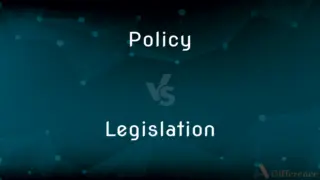Apoplast vs. Symplast — What's the Difference?
By Fiza Rafique & Maham Liaqat — Updated on May 14, 2024
Apoplast refers to the network of cell walls and intercellular spaces through which water and solutes move, while symplast is the interconnected cytoplasm of living cells facilitated by plasmodesmata.

Difference Between Apoplast and Symplast
Table of Contents
ADVERTISEMENT
Key Differences
The apoplast is made up of the cell walls and the spaces between plant cells, allowing movement of substances without crossing cell membranes, whereas the symplast consists of the cytoplasm of adjacent cells connected by plasmodesmata, enabling direct cytoplasmic transfer of materials.
Water and solutes travel freely through the apoplast pathway due to its open network, offering less resistance and no selective barriers, while in the symplast pathway, substances can move selectively from cell to cell regulated by the plasmodesmata.
Apoplastic transport does not involve crossing the cell membrane, which means it can be faster for substances moving longitudinally along plant tissues, on the other hand, symplastic transport involves crossing at least one cell membrane initially and then utilizes the cytoplasmic continuity for distribution, which can control and regulate the transport.
The apoplast is significant in the context of plant interactions with their environment, as it can influence the plant’s response to external factors like pathogens and pollutants, whereas the symplast plays a crucial role in the internal regulation of plant functions and intercellular communication.
In terms of solute transport, the apoplast does not support the movement of larger molecules that cannot pass through cell walls, while the symplast can transport a variety of molecules, including larger proteins and RNA molecules, between cells.
ADVERTISEMENT
Comparison Chart
Composition
Cell walls and intercellular spaces
Interconnected cytoplasm of cells
Pathway Characteristics
Free movement, non-selective
Selective, regulated movement
Transport Speed
Generally faster, less resistance
Slower, involves cell membrane crossing
Role
Influences response to environment
Crucial for intercellular communication
Molecule Size Supported
Small molecules and ions
All molecule sizes including large proteins
Compare with Definitions
Apoplast
The non-living part of plant tissues consisting of cell walls and intercellular spaces.
Water flows through the apoplast without entering the cells.
Symplast
The living part of plant tissue, comprising the interconnected cytoplasm of cells.
The symplast of the plant facilitates nutrient sharing among cells.
Apoplast
Allows for rapid transport of water and solutes laterally.
Nutrients dispersed quickly across the apoplast during irrigation.
Symplast
Supports the selective and regulated movement of substances.
Hormones are distributed efficiently through the symplast pathway.
Apoplast
Acts as a barrier and filter to pathogens and environmental toxins.
The apoplast filters out certain pollutants before they reach the living cells.
Symplast
Essential for the integration of plant metabolic activities.
The symplast integrates photosynthesis products for use throughout the plant.
Apoplast
Important in studies of plant pathology and physiology.
Scientists study the apoplast to understand disease resistance in plants.
Symplast
Can transport various molecules, including RNA and proteins.
Genetic information is conveyed from cell to cell via the symplast.
Apoplast
Does not permit the passage of larger molecules.
Large enzymes are unable to travel through the apoplast of the plant.
Symplast
Utilizes plasmodesmata for direct intercellular communication.
Signals are sent through the symplast to coordinate cellular responses.
Apoplast
Inside a plant, the apoplast is the space outside the plasma membrane within which material can diffuse freely. It is interrupted by the Casparian strip in roots, by air spaces between plant cells and by the plant cuticle.
Symplast
The symplast of a plant is the inner side of the plasma membrane in which water and low-molecular-weight solutes can freely diffuse. Symplast cells have more than one nucleus.
Apoplast
(botany) The space outside of a plant's plasma membrane through which water and soluble nutrients are transported across a tissue or organ
Symplast
(biology) The inner side of the plasma membrane of a plant in which water can freely diffuse.
Common Curiosities
How does symplast differ from apoplast?
Symplast involves interconnected cytoplasm of cells for regulated substance movement, unlike the more open apoplast.
What role does symplast play in a plant?
The symplast facilitates intercellular communication and regulates internal substance movement.
How do substances enter the symplast?
Substances must cross a cell membrane to enter the symplast, usually via active or passive transport.
What is the significance of plasmodesmata in the symplast?
Plasmodesmata allow the selective and regulated transfer of substances between cells in the symplast.
What is the apoplast?
The apoplast consists of the cell walls and intercellular spaces through which water and solutes move freely.
Why is apoplastic transport considered faster?
Apoplastic transport is faster due to the lack of cellular barriers, allowing more direct flow along cell walls.
Can apoplast transport proteins?
No, the apoplast generally cannot transport proteins because it only permits smaller molecules and ions.
Is the apoplast involved in plant disease resistance?
Yes, the apoplast can act as a barrier to pathogens and plays a role in the plant’s immune response.
Can symplast transport RNA molecules?
Yes, the symplast can transport RNA and other large molecules between cells.
How does the environment affect apoplastic transport?
Environmental factors like pH and salinity can affect the movement of substances through the apoplast.
Can symplast and apoplast pathways operate simultaneously?
Yes, both pathways often operate simultaneously, complementing each other in plant solute and water transport.
What role does the apoplast play in nutrient distribution?
The apoplast facilitates the quick distribution of ions and nutrients across different parts of the plant.
Can the apoplast transport water?
Yes, the apoplast is a major pathway for water movement in plants.
What are the limitations of symplastic transport?
Symplastic transport is limited by the size of plasmodesmata and the selective nature of cellular membranes.
How does apoplastic transport influence plant hydration?
Apoplastic transport allows for rapid lateral movement of water, helping in efficient hydration of plant tissues.
Share Your Discovery

Previous Comparison
Character vs. Integrity
Next Comparison
Policy vs. LegislationAuthor Spotlight
Written by
Fiza RafiqueFiza Rafique is a skilled content writer at AskDifference.com, where she meticulously refines and enhances written pieces. Drawing from her vast editorial expertise, Fiza ensures clarity, accuracy, and precision in every article. Passionate about language, she continually seeks to elevate the quality of content for readers worldwide.
Co-written by
Maham Liaqat















































